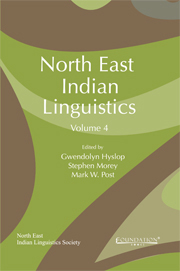Book contents
- Frontmatter
- Contents
- About the Contributors
- Foreword
- A Note from the Editors
- History, Contact and Evolution
- Bodo-Garo Grammar
- Orthography, Poetics and Text
- New Descriptions
- Classifiers
- Eastern Indo-Aryan Grammar
- Personal Pronouns in Madhav Kandali's Ramayana
- 16 Nominalization and the Nominalized Clause in Assamese
- 17 Copula Constructions in Assamese Sadri
- Austroasiatic
16 - Nominalization and the Nominalized Clause in Assamese
from Eastern Indo-Aryan Grammar
Published online by Cambridge University Press: 05 May 2013
- Frontmatter
- Contents
- About the Contributors
- Foreword
- A Note from the Editors
- History, Contact and Evolution
- Bodo-Garo Grammar
- Orthography, Poetics and Text
- New Descriptions
- Classifiers
- Eastern Indo-Aryan Grammar
- Personal Pronouns in Madhav Kandali's Ramayana
- 16 Nominalization and the Nominalized Clause in Assamese
- 17 Copula Constructions in Assamese Sadri
- Austroasiatic
Summary
Introduction
The North East of India is home to four language families: Indo-Aryan, Tibeto-Burman, Austroasiatic and Tai. Barbora (2010), Konnerth (2011), Huziwara (2011) and Post (2011) have looked into the nominalization process in some Tibeto-Burman languages of the region, namely Mising and Karbi, spoken in Assam, Marma, spoken in Tripura and Bangladesh, and Galo, spoken in Arunachal Pradesh. Notable descriptions of nominalization in Tibeto-Burman languages of North East India are also found in grammars by Coupe (2007) and by van Breugel (2008). Accordingly, a study of nominalization in Assamese, an Indo-Aryan language of North East India, should provide information that would be of value to linguists with interest in the areal typology of the North East Indian region. The goal of this paper is to present such a study.
A brief overview of Assamese grammar
Assamese is a head-final language with a subject-object-verb word order. An agglutinative language, Assamese nominals are inflected for number, classifiers and case. The feminine gender marker -i suffixes to the classifier -zɔn. In finite clause constructions, a nominal argument in A function takes overt case marking. In S function, a nominal argument normally does not take an overt case marker. Pronominals, whether in S or in A function, do not take overt case marking. In the O position only, animate nominals optionally take an overt case marker. Arguments in peripheral positions take overt case markers. Finite verbs are inflected for tense, aspect and mood (TAM).
- Type
- Chapter
- Information
- North East Indian Linguistics , pp. 339 - 352Publisher: Foundation BooksPrint publication year: 2012



